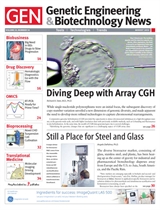Sep 6 2013
University of Alberta scientists completed a seven-year study that ultimately determined the chemical composition of human urine. The project, which involved a team of nearly 20 investigators using nuclear magnetic resonance spectroscopy, gas chromatography, mass spectrometry, and liquid chromatography, revealed more than 3,000 metabolites can be detected in urine.
The results are expected to have significant implications for medical, nutritional, drug, and environmental testing, say the researchers.
"As a biological waste material, urine typically contains metabolic breakdown products from a wide range of foods, drinks, drugs, environmental contaminants, endogenous waste metabolites, and bacterial by-products," wrote the scientists in this month's issue of PLOS ONE. "Many of these compounds are poorly characterized and poorly understood. In an effort to improve our understanding of this biofluid we have undertaken a comprehensive, quantitative, metabolome-wide characterization of human urine. This involved both computer-aided literature mining and comprehensive, quantitative experimental assessment/validation."
Most medical textbooks list only 50 to 100 chemicals in urine, and most common clinical urine tests measure only six to seven compounds, explained David Wishart, Ph.D, senior scientist on the team. "Expanding the list of known chemicals in urine by a factor of 30 and improving the technology so that we can detect hundreds of urine chemicals at a time could be a real game-changer for medical testing," he added.
He believes this study (entitled "The Human Urine Metabolome") is particularly significant because it will allow an entire new generation of fast, cheap, and painless medical tests to be performed using urine instead of blood or tissue biopsies. In particular, he notes that new urine-based diagnostic tests for colon cancer, prostate cancer, celiac disease, ulcerative colitis, pneumonia, and organ transplant rejection are already being developed or are about to enter the marketplace, thanks in part to this work.

 This article was reprinted from Genetic Engineering & Biotechnology News (GEN) with permission from Mary Ann Liebert, Inc., publishers. Genetic Engineering & Biotechnology News (GEN) has retained its position as the number one biotech publisher around the globe since its launch in 1981. GEN publishes a print edition 21 times a year and has additional exclusive editorial content online, like news and analysis as well as blogs, podcasts, webinars, polls, videos, and application notes. GEN's unique news and technology focus includes the entire bioproduct life cycle from early-stage R&D, to applied research including omics, biomarkers, as well as diagnostics, to bioprocessing and commercialization.
This article was reprinted from Genetic Engineering & Biotechnology News (GEN) with permission from Mary Ann Liebert, Inc., publishers. Genetic Engineering & Biotechnology News (GEN) has retained its position as the number one biotech publisher around the globe since its launch in 1981. GEN publishes a print edition 21 times a year and has additional exclusive editorial content online, like news and analysis as well as blogs, podcasts, webinars, polls, videos, and application notes. GEN's unique news and technology focus includes the entire bioproduct life cycle from early-stage R&D, to applied research including omics, biomarkers, as well as diagnostics, to bioprocessing and commercialization.